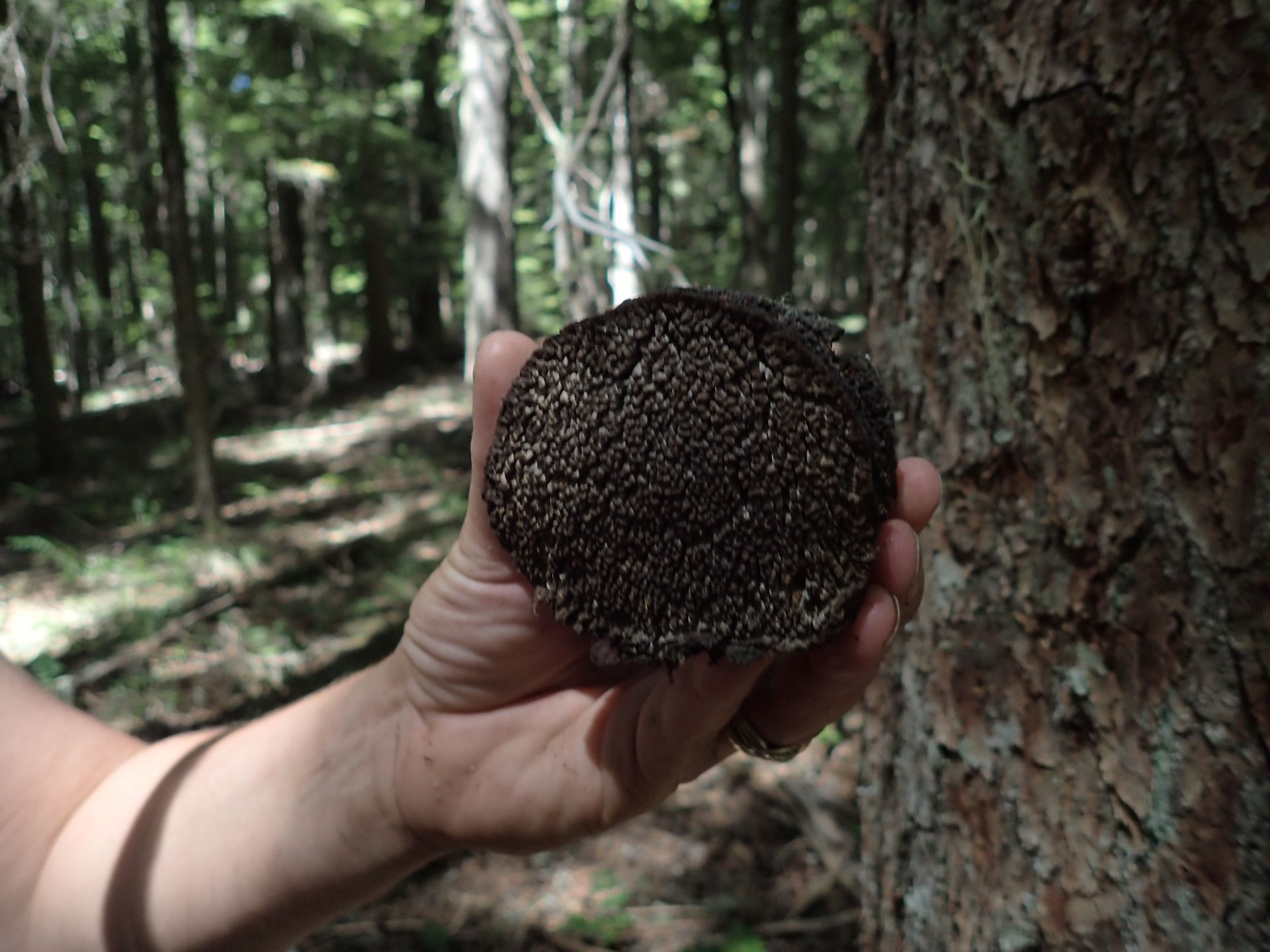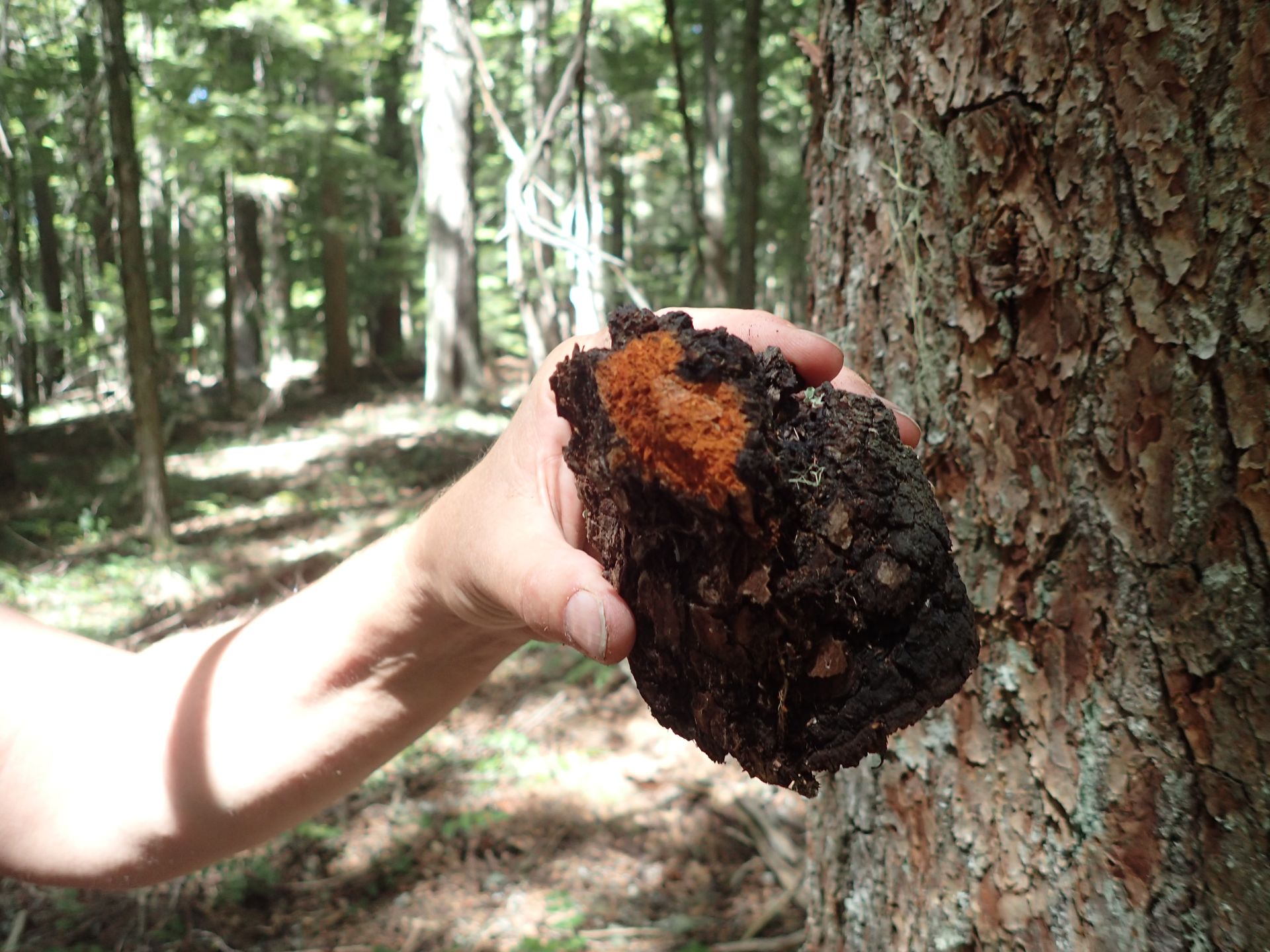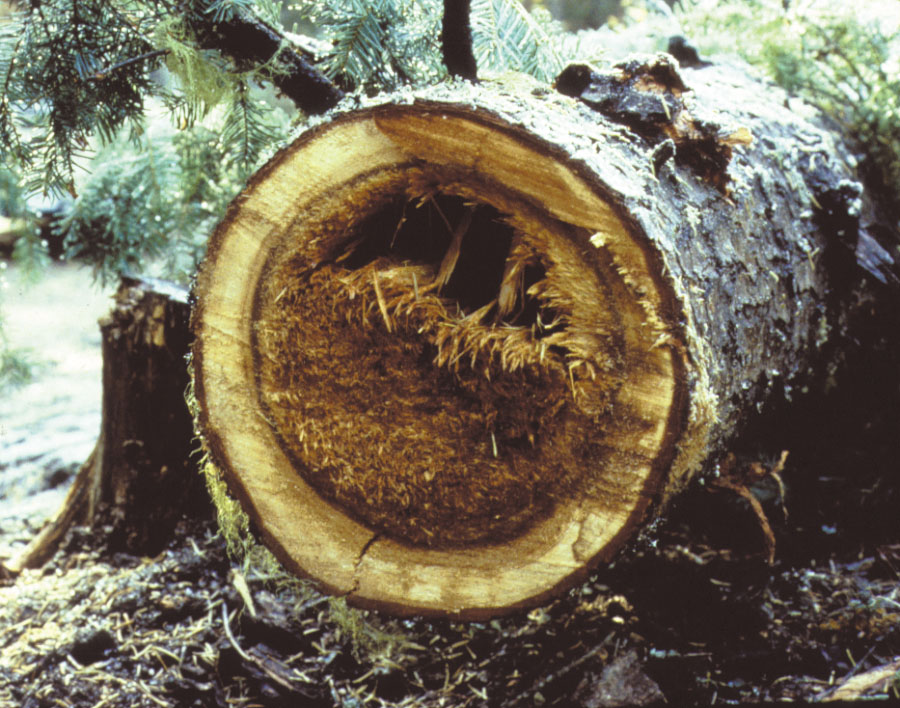Indian Paint Fungus (Rust-red stringy rot)
Echinodontium tinctorium
Key Wildlife Value:
Indian paint fungus causes decayed heartwood and hollow stems in living small-size and larger true fir and hemlock trees. Hollow stems are created during advanced stages of decay, when cylinders of rotted heartwood detach from surrounding sapwood and collapse, causing formation of a hollow chamber. Heartwood weakened by this fungus provides a substrate suitable for cavity excavation, while hollow stems provide ready-made cavities for nesting, roosting, resting, hunting, and denning. Decayed and hollow stems also provide areas of weakness where stem breakage may occur. Broken tops may provide points of entry to hollow stems, or, in conjunction with green limbs remaining near breaks, may provide structures useful for nesting or roosting. Stem breakage contributes to the formation of canopy gaps, increasing structural diversity, and adds decayed wood elements to the forest floor.
Distribution in Oregon and Washington:
Commonly found east of the Cascades crest in Oregon and Washington, in the transition zone of the crest, and in southwestern Oregon; relatively uncommon west of the Cascades crest in northwestern Oregon and western Washington.
Hosts:
Primarily true firs and hemlocks.
Diagnosis:
Fruiting bodies are hoof-shaped, woody, and rough-textured conks,



Early decay appears as a light-brown stain in the heartwood that is softer than normal. Thin rusty-red or black zone lines may also be present. As the decay progresses, the soft heartwood appears to separate along annual rings, and is rust-red to brown and stringy when pulled apart. Advanced decay produces masses of long, stringy, rust-red fibers; eventually hollow stems may result.

Life History:
Windborne spores infect new host trees, usually when the trees are small and growing in the understory, through tiny (less than 2 mm) dead branchlet stubs. Spores germinate and mycelia grow within the branchlet until it is overgrown by healthy tissue. The fungus then enters a dormant phase as a resting spore, surviving for 50 years or more until activated by a tree wounding injury that allows air into the trunk interior near the resting spore. The wound must be located within about 30 cm (1 ft) of the dormant infections to trigger activity.
Once activated, decay develops rapidly in the heartwood. Fruiting bodies (conks) form on the tree bole after extensive decay has developed and typically produce spores for several years. Conks on trees that have died or been felled may produce spores for as long as 10 years after death.
Important Habitats and Spread Dynamics:
Suppressed, slow-growing trees are more likely to be infected by Indian paint fungus than fast growing trees, because they tend to have more shade-killed branchlets and to overgrow dead branchlet stubs more slowly, providing increased opportunities for infection. Thus Indian paint fungus is most common in stands that developed from dense, suppressed, true fir and hemlock understories growing under infected overstories, especially on sites where tree vigor is low. Advanced true fir and hemlock regeneration east of the Cascades crest that is more than 50 years old is likely to contain high levels of infection by Indian paint fungus. Cool, moist sites such as those found near water, on north aspects, on lower slopes, and under dense shade, as well as uneven-aged stand structures favor spread and infection by this fungus.
Wounds that activate dormant infections are commonly caused by mechanical injuries to the tree bole, frost cracks, or the breaking of a large-diameter branch close to the tree bole. Selective harvest activities and weather events that cause limb breakage and bole wounding can initiate decay formation by activating resting spores inside the tree bole.
Decay caused by E. tinctorium is often most common in the mid-bole, but may also extend into the butt or upper region of the stem. On average, trees with a single conk contain about 40 feet of continuous heartwood decay, with about half of the decay occurring above the conk and the other half below. Trees with many conks occurring at wide intervals up the bole are likely to be decayed for nearly their entire length.
Opportunities for Manipulation to Increase Wildlife Habitat:
Stands containing host trees, especially grand fir or white fir, that are managed on long rotations of 120 years or longer are likely to develop decay that provides useful structures for wildlife sheltering, nesting and denning. In the Eastside, southwest Oregon, and the Cascades crest transition zone, E. tinctorium and its accompanying decay activity may be conserved and continual activity encouraged during stand management activities by retaining selected areas having older true firs or hemlocks (120 years old or older) and dense thickets of advanced true fir or hemlock regeneration.
In stem-decay-deficient stands having no evidence of previous wounding, and that have a component of true fir or hemlock trees that developed from advanced regeneration, it may be desirable to try activating dormant infections by intentionally wounding selected reserve host trees by limbing, topping, or removing large sections of bark from the bole.
Potential Adverse Effects:
Decay caused by Indian paint fungus may sometimes be so prevalent in older, predominantly host species stands that undesired degradation of the existing stand structure occurs as a result of high levels of stem breakage. Riparian stands having a very high incidence of advanced rust-red stringy rot decay may not provide adequate long-term coarse woody inputs to the aquatic system, because the trees tend to shatter when they fall across the stream channel, or to float away during high-water events. On recreational and administrative sites, trees having advanced decay caused by Indian paint fungus (indicated by a single large conk) have a high potential for failure and may present a significant safety hazard.
How to Minimize the Risk of Adverse Effects:
When regenerating, employ even-age or group selection regeneration systems. Promoting non-host tree species, or a mixture of host and non-host tree species, when regenerating or thinning will help to reduce the rate of breakage in the future mature stand. Avoid excessive wounding of residual host trees in during selective harvest or other silvicultural activities, because wounding activates dormant infections. When managing true fir or hemlock in areas with a high incidence of Indian paint fungus, avoid retaining advanced regeneration older than 50 years of age, and limit harvest rotations to 150 years or less. On recreational and administrative sites, trees within striking distance of a target that have conks or discernable decay exceeding prescribed levels should be removed or topped to a safe height, or the situation arranged so that people are not exposed to danger.
Managing suppressed understories that develop under infected overstories for long-term goals will maintain high levels of Indian paint fungus and associated stem breakage within a stand. A hazard rating method has been developed by Filip et al. (1983) to estimate the percentage of infection by Indian paint fungus in advanced grand fir and white fir regeneration in eastern Oregon and Washington. For situations where lower levels of decay are a management goal, this hazard rating system also provides guidelines for deciding whether to manage existing advanced regeneration for overstory replacement and for determining optimal rotation lengths. Generally speaking, it is helpful to maintain good growing conditions for understory trees that are less than 50 years old by providing adequate space for vigorous tree growth.
References
Aho, P.E. 1982. Indicators of cull in western conifers. USDA Forest Service, Pacific Northwest Research Station, Portland, OR. Gen. Tech. Rep. PNW-GTR-144. 17 pp.
Bull, E.L., C.G. Parks, and T.R. Torgersen. 1997. Trees and logs important to wildlife in the interior Columbia River Basin. USDA Forest Service, Pacific Northwest Research Station, Portland, OR. PNW-GTR-391. 55 pp.
Etheridge, D.E., and H.M. Craig. 1976. Factors influencing infection and initiation of decay by the Indian paint fungus (Echinodontium tinctorium) in western hemlock. Can. J. of Forest Research. 6:299-318.
Filip, G.M., P.E. Aho, and M.R. Wiitala. 1983. Indian paint fungus: a method for recognizing and reducing hazard in advanced grand and white fir regeneration in eastern Oregon and Washington. USDA Forest Service, Pacific Northwest Region, Forest Health Protection, Portland, OR. R6-FPM-293-87. 24pp.
Filip, G.M., K.L. Chadwick, P.J. Zambino, D.W. Omdal, A. Ramsey-Kroll, C.L. Schmitt, H. Maffei, A. Saavedra, W. Rall, and C.G. Parks. 2011. Seven- to 14-year effects of artificially inoculating living conifers to promote stem decay and subsequent wildlife use in Oregon and Washington forests. Portland, OR: USDA Forest Service, Forest Health Protection, Pacific Northwest Region. 24 pp.
Filip, G.M. and C.L. Schmitt. 1990. Rx for Abies: silvicultural options for diseased firs in Oregon and Washington. USDA Forest Service, Pacific Northwest Research Station, Portland, OR. GTR-PNW-252. 34pp.
Goheen, E.M. and E.A. Willhite. 2006. Field guide to common diseases and insect pests of Oregon and Washington conifers. USDA Forest Service, Pacific Northwest Region, Portland, OR. R6-NR-FID-PR-01-06. 335 pp. http://www.biodiversitylibrary.org/bibliography/80321#/summary
Hansen, E.M. and K.L. Lewis, eds. 1997. Compendium of conifer diseases. American Phytopathological Soc. Press. 101 pp.
Website links
Western Forest Insects and Diseases: Publications and Links
Forest Insect and Disease Leaflets - decays - true firs & hemlock